This week’s seminar was devoted to listening to one of the lessons from the book (with matching CD) Critical Listening Skills For Audio Professionals, the object of which I presume is to refine our ability to focus our auditory perception to the high levels necessary to make successful audio engineering decisions. We examined variations in level at given frequencies, amongst other things and determined that changes in level are generally more noticeable at lower frequencies and louder (starting) levels. In speech as well as music, 2dB is (for most people) the smallest detectable change in level, which we discovered by listening to endless repeats of the same paragraph of text and the same extract of music. It would have been vastly more entertaining had the reader demonstrated this point by telling a dirty joke and playing fragments of say, The Legendary Stardust Cowboy but I appreciated the lesson nevertheless. It was also postulated that “random noise” can be defined as noise or sound which is constantly shifting in frequency and amplitude and we listened to examples of such with specified centre frequencies. The narrower the bandwidth around that centre frequency, the more “like” that frequency the noise becomes. Sadly, this puts paid to my claim that my bands are all based around random noise.
References
Everest, F. 2006, Critical Listening For Audio Professionals, Course Technology, Boston.
Whittington, S., Concepts of Music (Aural) Seminar (personal notes) 31/07/08
Monday, August 4, 2008
SES WEEK 1 STUDIO 1 SIGNAL FLOW
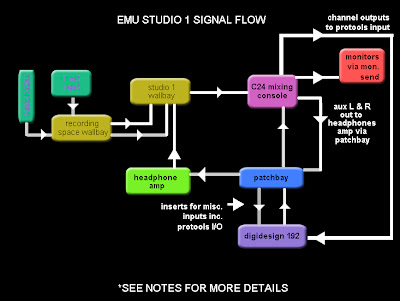
This week’s exercise involved describing the signal flow from a microphone or DI’d signal in the recording space to Pro Tools in Studio 1. To achieve this I teamed up with Sam Deere and we obtained the necessary information from the EMU (Studio) Guide, Dave Grice during the week 1 seminar and a physical inspection of Studio 1. The assignment also required a description of the talkback, headphones and studio monitors signal flows all of which should be covered by the above diagram. For extra explanatory notes, see below.
Notes:
* Patchbay inputs to Pro Tools are normalised (ie: no patchbay plugs required)
* Pro Tools outputs to patchbay are not normalised and need to be patched (Pro Tools 1 and Pro Tools 2 outputs to C24 Pro Tools source 1 and C24 Pro Tools source 2 inputs)
* For headphones mix, select monitor> auxiliary on C24
* Talkback via desk microphone, automatically patched to headphones (aux) send
* To patch a microphone or DI input via the Avalon pre-amp, the signal path between the microphone inputs at the Studio 1 wallbay is broken by inserting the dedicated Avalon input (mic signal) lead into the signal path or (for a line level signal), plug the instrument directly into the socket on the front panel of the Avalon itself – either of these options will then need to be patched on the patchbay from Avalon Out to ProTools In
References:
D.Grice, EMU Studio 1 Signal Flow, Sound Engineering Studio Lecture, 29/07/08
Adelaide University, Electronic Music Unit, Resources, Guides, Spaces, Studio 1
http://emu.adelaide.edu.au/resources/guides/spaces/studio.1.html, viewed 03/08/08
Tuesday, July 29, 2008
MTF - WEEK 1 - TOM DOWD DVD
The DVD “The Language of Music” presented a fascinating journey through the history of music recording technology from the viewpoint of one of the most important figures in this field, Tom Dowd. Dowd’s tenure as a recording engineer and producer seems to have spanned over 50 years during which time music recording underwent the change from direct mastering (in the recording studio) to a rotating cylindrical disc, to ¼” mono tape recording, to 8 track multi-track recording destined for stereo playback and beyond. It’s interesting to note that the problems encountered by these very early direct-mastered recordings are still extant today when recording for vinyl release, ie: that these recordings were cut at 88 grooves per inch, which could be increased up to 160 grooves per inch but only by compromising the overall level (the result would be quieter) and risking the playback needle jumping out of the groove. A band that I recorded last semester at the EMU wants to release their recording on vinyl and when we made enquiries at Australia’s only vinyl pressing plant (Zenith Records) we found that the same principle still applies, ie: that the longer the recording, the closer the groove spacing, the quieter the overall level will be, with risk of needle jumping.
References
Anon, Preparing Your Master, Zenith Records
http://www.zenithrecords.org/masters.html, viewed 03/08/08
C. Haines, Seminar, Music Technology Forum, 29/07/08
Various, The Language of Music (DVD), 2003
(Mark Moorman)
References
Anon, Preparing Your Master, Zenith Records
http://www.zenithrecords.org/masters.html, viewed 03/08/08
C. Haines, Seminar, Music Technology Forum, 29/07/08
Various, The Language of Music (DVD), 2003
(Mark Moorman)
Friday, June 27, 2008
SOUND ENGINEERING (STUDIO) A - STUDIO PROJECT

The band I chose to record for this project is local 3 piece "Glamville". Their line-up consists of drummer, guitarist/vocalist and bass player/ vocalist and their musical style could be described as jazz-punk. I knew Glamville would be a difficult recording subject as their songs are very loosely structured and the element of spontaneity is paramount in their musical ethos, rendering it difficult to record one instrument at a time to maintain absolute production cleanliness. In the studio, I compromised with the band to the extent where I managed to separate them physically by placing the guitarist in the dead room and the drummer and bass player in the recording space with baffles strategically positioned. Naturally I still had trouble with spill but the band was happy to be able to lay the bed tracks down together simultaneously. The bed tracks were laid in 2 x 4 hour sessions with another 4 hour session allocated to overdubbing extra guitar parts, vocals and a last-minute piano track. I then spent around 12 hours mixing down, cleaning up and generally earning my keep as a putative sound engineer. Click to below to hear the result.
MP3 MIXDOWN - GLAMVILLE - HERMETIC CO-ORDINATES - CLICK HERE
MP3 MIXDOWN - GLAMVILLE - INSOLUBLE SOLUTION - CLICK HERE
PROJECT PRODUCTION AND RECORDING NOTES PDF - CLICK HERE
Labels:
glamville,
punk-jazz,
recording,
sound production,
tion
Wednesday, June 25, 2008
AUDIO STUDIES - CREATIVE PROJECT
Program Note
Emu Challenge
Dorothy Pawlowski
03:14
EMU CHALLENGE MIXDOWN MP3 - CLICK HERE
Whenever I think of video game music, I think of the music of the Commodore 64 and (later) the Super Nintendo gaming consoles of the 1980’s. By today’s standards, these machines were capable of producing only low resolution audio, often played back through a small speaker. The result was usually brittle, noisy and trashy.
When writing this, my own hypothetical video game music ”Emu Challenge”, I deliberately attempted to emulate the sound of early digital audio by including “noisy” percussion samples and copying the vibrato-heavy, string-like synthesizer sounds which were typically used for melody instruments at the time.
Emu Challenge
The hero of this video game is an emu who faces challenges within three main gaming zones namely, The Adventure Zone, The Spooky Zone and The Fun Zone. All of the sequencing for the final work was carried out in Pro Tools LE (session bit depth 24 and sample rate 48kHz).
The percussion samples for the work were obtained either from the Garage Band library or manufactured using the ES1 and FM synthesizers in Logic Pro). I obtained sound effects from the web as well as recording voice tags which I felt would emphasise the “game” flavour of the music, editing and normalising some of the samples in Peak LE as necessary. The melodic components were composed in Logic Pro using the matrix editor and ES1 synthesizer, which I found most appropriate to the style of music. I exported the melodies as 24 bit wav audio files from Logic and imported them into the Pro Tools region list, converting the sample rate to match the Pro Tools session sample rate. The Spooky Zone melodies utilised the “swing” function of Logic, as I wished this section to have a less rigid feel to the meter.
After manufacturing, recording and collecting all of this source material, I arranged it accordingly in Pro Tools, mostly using grid mode, and performed mixing, panning, automation and organisational operations as well as applying plug-ins. Although normalised, there were still problems with varying levels between the vocal effects tags and there were no tracks left over to allocate each tag a track of its own (as I had already used all of the tracks available in Pro Tools LE at this sample rate and bit depth), so volume automation was particularly necessary on the two “FX” tracks.
The Adventure Zone
Meter: 4/4
Tempo: 160 bpm
Key: C minor
(In this section I have departed from my original idea (as per proposal) of using C major as the key because I found when I began writing the melody that the feeling of a strictly major key was not “dangerous” enough.)
The Spooky Zone
Meter: 4/4
Tempo: 160 bpm
Key: G minor
The Fun Zone
Meter: 6/8
Tempo: 180 bpm
Key: C major
Production Credits
Voice Tags: Captain I (appears by permission of Sleazy Studios)
Emu Challenge
Dorothy Pawlowski
03:14
EMU CHALLENGE MIXDOWN MP3 - CLICK HERE
Whenever I think of video game music, I think of the music of the Commodore 64 and (later) the Super Nintendo gaming consoles of the 1980’s. By today’s standards, these machines were capable of producing only low resolution audio, often played back through a small speaker. The result was usually brittle, noisy and trashy.
When writing this, my own hypothetical video game music ”Emu Challenge”, I deliberately attempted to emulate the sound of early digital audio by including “noisy” percussion samples and copying the vibrato-heavy, string-like synthesizer sounds which were typically used for melody instruments at the time.
Emu Challenge
The hero of this video game is an emu who faces challenges within three main gaming zones namely, The Adventure Zone, The Spooky Zone and The Fun Zone. All of the sequencing for the final work was carried out in Pro Tools LE (session bit depth 24 and sample rate 48kHz).
The percussion samples for the work were obtained either from the Garage Band library or manufactured using the ES1 and FM synthesizers in Logic Pro). I obtained sound effects from the web as well as recording voice tags which I felt would emphasise the “game” flavour of the music, editing and normalising some of the samples in Peak LE as necessary. The melodic components were composed in Logic Pro using the matrix editor and ES1 synthesizer, which I found most appropriate to the style of music. I exported the melodies as 24 bit wav audio files from Logic and imported them into the Pro Tools region list, converting the sample rate to match the Pro Tools session sample rate. The Spooky Zone melodies utilised the “swing” function of Logic, as I wished this section to have a less rigid feel to the meter.
After manufacturing, recording and collecting all of this source material, I arranged it accordingly in Pro Tools, mostly using grid mode, and performed mixing, panning, automation and organisational operations as well as applying plug-ins. Although normalised, there were still problems with varying levels between the vocal effects tags and there were no tracks left over to allocate each tag a track of its own (as I had already used all of the tracks available in Pro Tools LE at this sample rate and bit depth), so volume automation was particularly necessary on the two “FX” tracks.
The Adventure Zone
Meter: 4/4
Tempo: 160 bpm
Key: C minor
(In this section I have departed from my original idea (as per proposal) of using C major as the key because I found when I began writing the melody that the feeling of a strictly major key was not “dangerous” enough.)
The Spooky Zone
Meter: 4/4
Tempo: 160 bpm
Key: G minor
The Fun Zone
Meter: 6/8
Tempo: 180 bpm
Key: C major
Production Credits
Voice Tags: Captain I (appears by permission of Sleazy Studios)
Labels:
audio,
Captain I,
Logic Pro,
Pro Tools,
sequencing,
Sleazy Studios,
video game music
Tuesday, June 17, 2008
MIDI STUDIES A - CREATIVE PROJECT
Other Girlfriend – An original song
By Dorothy Pawlowski
03:48
The concept behind this rendering of Other Girlfriend was to take a simple song that I wrote for a punk-pop band, and re-work it into a suitable format for the dance floor.
I began by writing the bass line using a MIDI track and a virtual software synth (the ES1), as the simple bass line determines the overall structure of the entire song. In order to rewrite the song as a dance piece in the context of a MIDI file, it was necessary for me to write all of the drum beats completely from scratch. To do this I used the Ultrabeat function of Logic Pro, which is a multi-timbral virtual drum machine that occupies only one MIDI instrument track within Logic. I wrote several different drum beats, modifying the preset drum samples to suit my needs, ie: changing them to “fat” sounds with a lot of distortion. When I had the drum beats completed, I arranged them as required in the arrange window and added two more virtual instrument MIDI tracks for melody parts, one with Garage Bands Morph Synthesizer.
At this point I wished to add some audio tracks in the form of vocals. I decided to do this in Studio 2 but had some difficulty getting an audio signal into Logic there. In order to overcome this, I recorded the vocal tracks in Pro Tools and later synchronised them back into Logic in the Audio Lab. After arranging the main vocal tracks appropriately, I chopped smaller samples out of them and used these for effect in the “middle 32, breakdown” section.
I then established a Rewire track using Reason as the slave, feeding it back into Logic on two audio channels and wrote another MIDI track with “effects” type sounds to control this.
Finally, I applied plug-ins to channels as I felt necessary and automated these as well as volume and panning, particularly on the vocal channels which had level discrepancy issues which I felt could be corrected in this way.
OTHER GIRLFRIEND MIDI FILE
OTHER GIRLFRIEND MP3 MIXDOWN
By Dorothy Pawlowski
03:48
The concept behind this rendering of Other Girlfriend was to take a simple song that I wrote for a punk-pop band, and re-work it into a suitable format for the dance floor.
I began by writing the bass line using a MIDI track and a virtual software synth (the ES1), as the simple bass line determines the overall structure of the entire song. In order to rewrite the song as a dance piece in the context of a MIDI file, it was necessary for me to write all of the drum beats completely from scratch. To do this I used the Ultrabeat function of Logic Pro, which is a multi-timbral virtual drum machine that occupies only one MIDI instrument track within Logic. I wrote several different drum beats, modifying the preset drum samples to suit my needs, ie: changing them to “fat” sounds with a lot of distortion. When I had the drum beats completed, I arranged them as required in the arrange window and added two more virtual instrument MIDI tracks for melody parts, one with Garage Bands Morph Synthesizer.
At this point I wished to add some audio tracks in the form of vocals. I decided to do this in Studio 2 but had some difficulty getting an audio signal into Logic there. In order to overcome this, I recorded the vocal tracks in Pro Tools and later synchronised them back into Logic in the Audio Lab. After arranging the main vocal tracks appropriately, I chopped smaller samples out of them and used these for effect in the “middle 32, breakdown” section.
I then established a Rewire track using Reason as the slave, feeding it back into Logic on two audio channels and wrote another MIDI track with “effects” type sounds to control this.
Finally, I applied plug-ins to channels as I felt necessary and automated these as well as volume and panning, particularly on the vocal channels which had level discrepancy issues which I felt could be corrected in this way.
OTHER GIRLFRIEND MIDI FILE
OTHER GIRLFRIEND MP3 MIXDOWN
Tuesday, June 10, 2008
CONCEPTS OF MUSIC - WEEK 12 - PITCH PERCEPTION
Music is the audible manifestation of maths. Onya Pythagoras. OK, I am officially lost and if maths is the basis of all reality then I am doubly stuffed as neither maths nor reality is my best subject and I reckon I just might have my head up my hem hem. Anyway, Pyth apparently surmised that each of the 7 planets in our solar system would produce a musical note dependent upon its distance from the “centre” (being Earth in this hypothesis): like the different lengths of resonating strings, for example. This was called “Musica Mundana” or as we would say "Music of the Spheres" and would be indiscernible to our presumably too-worldly ears. What a beautiful idea. There IS a harmonic and numeric relationship between all things from the greatest in scale to the smallest; it has been well-documented in any number of mystic publications and websites but it still has credence for all that. Some people become obsessed with these relationships and are consequently and unkindly regarded by our society as cranks. I think it is well to notice the numeric underpinning to cosmic structure but do not let the the desire to understand it dominate your life, for what is... is.
Here is a source of entertaining misinformation about Pythagoras
References:
Stephen Whittington, Lecture, Concepts of Music (Aural), 05/06/08
John Boyd-Brent, Harmony and Proportion, http://www.aboutscotland.co.uk/harmony/prop.html
Viewed 10/06/08
Here is a source of entertaining misinformation about Pythagoras
References:
Stephen Whittington, Lecture, Concepts of Music (Aural), 05/06/08
John Boyd-Brent, Harmony and Proportion, http://www.aboutscotland.co.uk/harmony/prop.html
Viewed 10/06/08
Labels:
mathematics,
music,
Pythagoras
SOUND ENGINEERING STUDIO - WEEK 12 - MASTERING

This week it all came together in one neat package – mastering. I can see why this job is generally left to professionals after I spent 4 hours yesterday manically tweaking compressors and EQ’s attempting to get every possible dB out of my mixdown. Obviously, mastering is a balancing act between totally squashing the dynamics out of the music and pumping up the volume and I think it’s important to keep in mind something that Luke told us in the context of mastering in MIDI studies, that is: the Genre Test. Some kinds of music need dynamic nuance far more than others; so dance music can probably suffer having the crap compressed out of it in the name of volume, where chamber music probably shouldn’t. I think also that one should keep in mind the final medium: what’s the point in maintaining a full dynamic range when the eventual playback medium won’t support it? Personally, I’m finding the mastering process frustrating and difficult but I presume that a degree of skill will come with practice. All of our assessment projects will have to undergo some form of mastering, I suppose.
References:
David Grice, Lecture, Sound Engineering Studio, 03/06/08
Labels:
audio mastering,
sound engineering
MTF - WEEK 12 - STUDIOS
This week’s session involved having a decko at various music recording studios about town (sadly, I don’t see any of them advertising for staff) as well as an advertising audio-production-and-jingle-writing establishment. Anyway, they all look like fun places to work and I wish I did. Co-incidentally, I was treated to a personal tour of one of Adelaide’s commercial TV studios over the weekend, from an audio production perspective. At least, that’s how my friend presented his job to me but it seemed upon investigation to be vastly more complicated than that and he (my mate) wears a large number of technological hats simultaneously. Now THAT looks like some serious fun, however, the centralised nature of TV production in Australia renders this field of employment opportunity somewhat dubious... bummer. I’m starting to think about what I shall do with myself when this course is over. The possibility of working out of an existing studio as a music recording engineer seems a bit intermittent, particularly in Adelaide (and in light of what we have been studying in this subject) – am I good enough? Will it bring home the bacon? What other options are there? I think I would like to be a highly-paid academic...
References:
D. Grice, Lecture, Music Technology Forum, 03/06/08
References:
D. Grice, Lecture, Music Technology Forum, 03/06/08
Labels:
recording studio,
sound production,
TV studio
Saturday, June 7, 2008
MTF - STUDIO PRESENTATION (MIX)
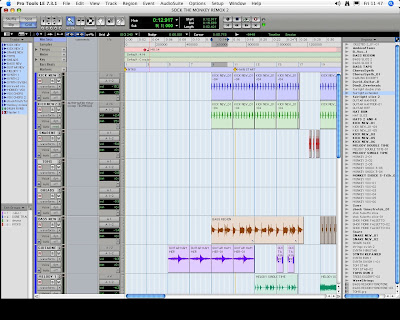
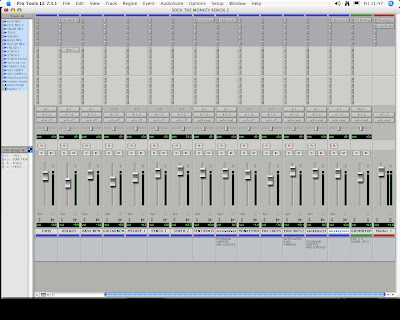
The audio files that I chose to remix originated from Peter Gabriel’s alternative rock/ new wave song “Shock the Monkey”, (released 1982 on Geffen) which was produced by Peter Gabriel and David Lord.
The overall structure of the audio is as follows:
31 x unsynchronised audio files of various durations
file type mp3 @ sample rate of 44.1 kHz(?)
no pro-tools session data
tempo nominally 148.64 bpm (according to supplied documentation)
time signature: 4/4
base-key: D minor
longest audio file: 04:08m
The audio tracks included:
various live percussion (several tracks)
bass guitar (several tracks)
electric guitar (several tracks)
synthesized brass (several tracks)
marimbas (and synthesized marimba)
lead vocals (several tracks)
back up vocals (several tracks)
various “filler” sounds (several tracks)
what sounds suspiciously like a Fairlight CMI
After performing the analysis of the provided audio as detailed above, I researched possible remix techniques. My initial researches in the Elder Music Library were surprisingly fruitless so I tried the internet. Most of the references to remixing that I did find were mostly in various sound production forums and were often unattributed (to “real” people). Eventually, however, I found five techniques that I thought I could reasonably interpret into my remix.
“Now ev’ry gambler knows that the secret to survivin’
Is knowin’ what to throw away and knowing what to keep.”
- Kenny Rogers, “The Gambler”
I began by analysing each track and decided what to remove and what to work with. I focussed on percussion and tuned percussion type sounds with vocals and some keyboard strings for contrast. After deleting unwanted tracks, I was left with 17 of the tracks to work with. I then decided how I wanted the remix to begin and set Pro Tools in grid mode with the tempo specified as 148.64bpm and the grid resolution set to 1/16.
This is when I applied remix technique No. 1 which formed the most important structural premise for my whole remix, namely:
“...my favorite (sic) thing is to chop up a bunch of loops and totally twist the song...1”
That is, to chop up whole audio files into smaller regions and sounds and restructure them into new loops and patterns. I chopped individual percussion hits out of percussion tracks and the attack segments of melodic tracks and recombined them into new drum beats. I used the same technique to make new melodic parts and bass lines using larger segments of the audio files. Once I had my basic drum patterns and melodic parts, I looped and recombined these to form the basis of the remix. Another aspect to this is:
“...skipping beats...2”
That is, totally removing percussive elements to give a syncopated feeling.
Next I applied a remixing technique where the kick drum track is duplicated twice and the copies are used to trigger both higher and lower kick drum sounds, then a phase shift is applied to the EQ of the duplicates, thus:
“...apply EQ phase sweep to kick drum copy...3”
I simplified the technique somewhat by just duplicating the kick drum track altogether then applying an automated filter sweep to the copy.
Next I applied (my personal favourite) from the “chopped and screwed” school of hip-hop remixing which involves:
“...select time stretch from the menu and time the tempo with the vocals as you change the pitch...4”
I applied this to both “normal” vocal parts and heavily chopped vocal parts.
The final technique which I used was gleaned from an article referring to methods to spoil unauthorised music downloads, like this:
“...shifting channels (sounds like a speaker cut out).5”
My channel shift was applied as panning automation synchronised to the grid.
Altogether, I enjoyed this exercise, not least because I detest the original song and was looking forward to making some improvements to it (hopefully).
References
1 “Uncle Jerr”, Studio Recording Engineer (forum)
http://www.studiorecordingengineer.com/ftopict-1019.html
Retrieved 20/05/08
2 Wikipedia
http://en.wikipedia.org/wiki/Chopped_and_screwed
Retrieved 20/05/08
3 Tom Holkenborg, Interview with Randy Alberts, Digidesign
http://www2.digidesign.com/digizine/archive/digizine_august04/protechniques/
Retrieved 20/05/08
4 “Mr. New Material”, Associated Content
http://www.associatedcontent.com/article/269048/the_perfect_mixx_how_to_chop_and_screw.html
Retrieved 02/06/08
5 Startling Moniker
http://startlingmoniker.wordpress.com/2007/09/20/mediadefender-remixes-chopped-screwed/
Retrieved 20/05/08
Labels:
audio,
PROTOOLS,
REMIX,
SHOCK THE MONKEY
Tuesday, June 3, 2008
CONCEPTS OF MUSIC - WEEK 11 - LOUDNESS CONT'D
For me, the outstanding part of this week’s discussion was the brief explanation of throat singing and the importance of pitch to the perception of speech generally. I suppose that it’s obvious to some that the vowel sounds of sung speech (singing) carry the pitch but it’s one of those things that I have never before considered and was therefore able to greet the knowledge with a “hey, wow” kinda attitude. Throat singing is an amazingly technical vocal style – check out this website which has a good explanation of some of the styles from different parts of the world and how they’re accomplished, as well as demonstration videos and links to similar sites (assuming you can be bothered of course).
Khoomei types
There is also a reference here to one Arthur Miles, obscure country-singin’ cowboy and a recording he made which features throat singing in a country and western context (dating from the 1920’s) – waaaay cool. So, have I been sitting here mouthing away at different droney vowel sounds in order gain a first-hand understanding of the relationship between changing harmonic series, tone colour and vowel sounds...? You’ll never know.
Listen to some throat singing
References
Stephen Whittington, Lecture, Loudness and Intensity, 29/05/087
http://khoomei.com/types.htm
viewed 03/06/08
Khoomei types
There is also a reference here to one Arthur Miles, obscure country-singin’ cowboy and a recording he made which features throat singing in a country and western context (dating from the 1920’s) – waaaay cool. So, have I been sitting here mouthing away at different droney vowel sounds in order gain a first-hand understanding of the relationship between changing harmonic series, tone colour and vowel sounds...? You’ll never know.
Listen to some throat singing
References
Stephen Whittington, Lecture, Loudness and Intensity, 29/05/087
http://khoomei.com/types.htm
viewed 03/06/08
Labels:
pitch,
speech,
throat singing,
vowel sounds
Saturday, May 31, 2008
SES WEEK 11 - COMPRESSORS AND GATES

Ah, gates explained (at last) and compressors explained (yet again). Which is OK. I feel I understand the concepts behind these two standards of audio equipment quite well yet whenever I actually apply one during the course of my mixing adventures, the results are... well, you know. So I have looked further for explanations to assist with my application of these tools (given that I had to leave this week’s session early and no doubt missed something important). I found yet another cool place to go for audio tutorials namely, Doctor ProAudio, which appears to be a site dedicated to the world-wide Spanish-speaking audiophile community but fear not, this page is en Inglés:
Doctor ProAudio compressors/limiters tutorial with link to gates tutorial
These tutes feature an excellent explanation of the (to me) mystifying concepts of side-chain and “knee”, which was a profound relief, lemme tell ya, as well as clear graphics (which actually help for a change). Armed with this new cache of e-knowledge and in conjunction with my D-learning (Dave), I shall no doubt be able now to produce mixes of the very highest quality. We can only wait and see.
References:
D. Grice, Lecture, Sound Engineering Studio, 27/05/08
http://www.doctorproaudio.com/english/
Doctor ProAudio, viewed 31/05/08
Labels:
audio,
COMPRESSOR,
NOISE GATE
MTF - WEEK 11 - LOCAL RECORDINGS
Listening to a variety of recordings that Dave G provided, we attempted to determine which ones had been recorded in Adelaide studios. Personally, I found the task impossible although Dave maintained that he could tell an Adelaide recording, particularly from certain studios. I find this a bit sad; the implication that a given set of equipment, personnel and space will result in a given sound or possibly flavour to the production. I think the lesson was supposed to demonstrate to us that it is possible to produce quality audio product in SA and the question was raised that, in these circumstances, why don’t more musicians come here to give birth to their sonic babies? I reckon it comes down to vibe; you’ve slaved over these songs, cried over them and they mean everything to you, surely you want to get all hyped up about giving them to the world. Perhaps for most people this means going somewhere that the air fairly pulsates with the vibrancy of overpopulation, I dunno. Later we listened to Adelaide engineering examples in the form of remixes from Lauren, Kristie and Shane – well done, guys! You have set the standard...
Here is an example of an Adelaide recording - guess who?
References
D. Grice, Lecture, Music Technology Forum, 27/05/08
D. Lokan, Lecture, Music Technology Forum, 27/05/08
Here is an example of an Adelaide recording - guess who?
References
D. Grice, Lecture, Music Technology Forum, 27/05/08
D. Lokan, Lecture, Music Technology Forum, 27/05/08
Monday, May 26, 2008
CONCEPTS OF MUSIC AURAL - WEEK 10 - INTENSITY AND LOUDNESS

I’ll try not to boringly whine on about the maths-heavy handout which we received this week, allegedly in order to facilitate our understanding of sound pressure level and the decibel measurement of sound intensity. It is obvious to me that I shall never be ein Tonmeister. Yes, I matriculated in maths but that was 24 years ago and I can honestly say my application of higher maths functions during my adult life has been, nil, nada, zero and zip. Oh, that’s not a whinge, by the way, I’m just nonplussed by the possible necessity of arithmetic function in my chosen future career. Am I padding my blog with BS? Um, yep sorry. However, it would be interesting to investigate exactly how many of the reasonably (and sometimes very) successful engineers and producers that we have been studying in Music Technology Forum have any grasp whatsoever (and if any, to what degree) of the maths tied to their jobs. One could probably maintain a perfectly respectable sound engineering life without this mathematical knowledge, however, the real issue is: can one pass this component of the Diploma without it? I may have to read it after all. Damn.
References:
S.Whittington, Lecture, Concepts of Music (Aural), 22/05/08
Saturday, May 24, 2008
SES - WEEK 10 - MIXING DOWN

At last, some real help with the mix down process, which I so desperately wanted. I love the idea of taking a “reference CD’ to the studio and referring to it regularly; to gauge the frequency response of the room, to give your ears a “control”, to give yourself pause from the constant focus on noise. I find this very tiring; to concentrate for long periods on sounds and try to read nuances into them while attempting to determine the effects of infinitesimal parameter changes. The “compare” function in the PT plug-ins window is of great use when confronted with this issue. Dave is right when he says “mix quietly”. I have to battle the temptation to mix at louder volumes because frankly, everything sounds better when you turn it up – there seems to be more bottom end which is so soul-satisfying… until you get it home and it blows your crappy stereo speakers or shakes your little earphones to pieces. The technique Dave showed us of starting with drums seemed logical to me but I had not thought to mix the kick drum in comparison with the bass instrument as a starting point. Good idea.
References:
D. Grice, Sound Engineering Studio Lecture, 20/05/08
MTF - WEEK 10 - CD MANUFACTURE

As I sit here drinking a damn’ fine wine, I ponder on what it takes to get one’s music noticed in this musically super-saturated world. Obviously, I have had (up until now) no bloody idea ‘cos no-one’s ever taken a blind bit of notice of mine… actually, we did chart well locally, I suppose. Perhaps if I had wrapped my CD’s in balloons and launched them at A& R executives they may have attracted some notice. Given my feelings towards the commercial music industry, however, it may have been more appropriate possibly for me to nail my CD’s to bricks and launch them at A & R execs’ heads, oh tut. Anyway, I have investigated further the intricacies of the CD production process and, as a consequence, here is this week’s handy-dandy link so that you can share in my findings (should you be so inclined):
MANUFACTURING PROCESS FOR DATA CD ROM AND AUDIO CD
WRITTEN BY: TERRY MCLEAN; ARTICLE PUBLISHED: YEAR 2006, MONTH 12;
It’s all about fathers, apparently – Freud would have a field day. Really, very interesting and yes, I was one of those who had laboured under the misconception that CD’s were all laser burned, live and learn.
References:
D.Grice, Music Technology Forum Lecture, 20/05/08
T. McLean, e-Tutorial, Manufacturing Process for Data CD Rom and Audio CD,
http://e-articles.info/e/a/title/Manufacturing-process-for-data-CD-ROM-and-audio-CD/, viewed 24/05/08
Multishape CD-Rom, viewed 24/05/08
http://www.multishapecdrom.com/cd_showcase/?case=irr_01
Labels:
BALLOON,
CD,
MANUFACTURE,
WINE
Monday, May 19, 2008
CONCEPTS OF MUSIC WEEK 9 LOUDNESS
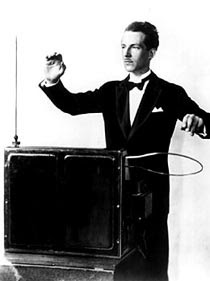
I know you all think I’m mad because I reckon foetuses can perceive ultrasound when being bombarded with such – perhaps my un-researched reasoning is wrong (I believe that the smaller the ear canal, the higher the detectable frequencies), but I’ve seen the little unborn ones reacting to the ultrasound procedure with my own eyes… co-incidence, conspiracy?
Check this link if you’re interested:
Is this relevant to our discussion this week? Yes, as we investigate the nature of intensity and relative loudness, infrasound and ultrasound, heterodyning (which has meaning beyond the scope of audio). Once more Stephen has juxtaposed the physical and psycho-physical aspects of sound. This increased knowledge of the nature of sound is having an effect on the way I listen when I’m recording and mixing down, although the conditions at the EMU are relatively sterile (“relative” to my usual musical environment which often involves beer-fuelled chaos and countless uncontrollable noises). To put it in a nutshell, I am trying soooo hard to listen with my brain, balancing the pure auditory input with the new knowledge about the way sound (mis)behaves and the way I perceive it (mis)behaving.
References:
S. Whittington, Lecture, Concepts of Music (Aural), 15/05/08
Wikipedia
http://en.wikipedia.org/wiki/Equal-loudness_contour
viewed 19/05/08
Chicago Tribune Online Edition
http://nie.chicagotribune.com/activities_082905.htmhttp://www.hhs.gov/
viewed 19/05/08
AUDIO STUDIES WEEK 9 PT SEQUENCING CONTD
So we continue our journey in and around Planet Pro Tools. I’m chuffed to discover that all plug-in parameters can be automated and further that they can be controlled with external controllers; the Novation keyboard in the audio lab and presumably the mixing desk in Studio 1. I’ve found the plug in information that we are covering very useful at the moment as I have been working on a demo for a band that I somewhat impetuously began a while back, before realising that I would be flat out doing assignments and have no time to indulge myself with free studio time, sigh. Strangely, the more I use the plug-ins in all their saveable, copy-and-pasteable glory, the more my mix sounds like crap! I am going to adopt the attitude of a female, fin-de-siecle, photographer (whose name eludes me at the mo’) to the effect that for her, the photograph ended at the negative; cropping, exposure compensation and other post-negative manipulation were just so much toss. Adapt this to the recording studio and it becomes; the band must sound perfect before it is even worth beginning, the vibe must be right and the music wonderful. Plug-ins are cake-icing.
GLAMVILLE
References:
C. Haines, Lecture, Audio Studies, 14/05/08
GLAMVILLE
References:
C. Haines, Lecture, Audio Studies, 14/05/08
SES WEEK 9 BASS AMP RECORDING
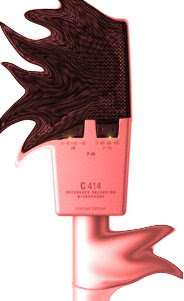
This week we continued our study into the studio recording of conventional rock band instruments by recording a bass amp using a range of microphones and direct inputs in both the dead room and the live recording space. Through this exercise we concluded that there wasn’t a great deal of difference in the sound quality between the two recording spaces, however, there was a noticeable difference between the various microphones and D.I.’s. We recorded the bass amp in ideal conditions, that is when there were no other instruments present to “spill” into our microphones. Obviously, one would have to think again in terms of amp positioning and baffling if a full band were present. The microphones we used were the AKG C414, Shure Beta 52, Shure Beta 57, Shure SM56 as well as a direct input from the bass guitar and a direct input from the bass amp (which happened to have such a facility). My personal favourite combination of these was the SM56 mixed with the guitar DI, mainly because of the warm richness in the tone. However, if I didn’t want warm rich tones, I might use something else. Depends on the desired effect.
Here is my recording of a bass amp
References:
D. Grice, Lecture, Bass Amp Recording Techniques, 13/05/08
Labels:
bass,
microphone,
recording
MTF WEEK 9 CLASS PRESENTATIONS
This week’s in-class presentations were ably presented by presenters Lauren, Ryan and Anthony with Joe presumably presenting apologies for his lack of presence.
Lauren chose producer Timbaland who has worked with such popular “artists” as Missy Elliot and Justin Timberlake amongst others. Lauren is obviously a fan of Timabland’s work, an advantage to her enthusiastic delivery. She supported her research with graphic material and audio samples which she used to demonstrate her points regarding Timbaland's “flava”, evident in his use of syncopation and percussion- heavy production. Here’s a sample of the Aaliyah song that I quite like.
What If, AALIYAH
Ryan researched British producer Hugh Padgham, allegedly responsible for the highly distinctive “gated-snare” sound of the 80’s – what a guy. Ryan again chose to present with a range of media and had obviously researched his subject’s engineering techniques very well.
Last up was Anthony and his presentation on one Adam Dutkiewicz, who in his spare time is also the drummer for Killswitch Engage. Adam has also worked with Parkway Drive (amongst others) as well as producing his own band. Anthony’s presentation took the form of another multi-media event and was highly entertaining and informative.
References:
A. Zillante, In-Class presentation, 13/05/08
L. McMahon, In-Class presentation, 13/05/08
R. Gerlach, In-Class presentation, 13/05/08
Lauren chose producer Timbaland who has worked with such popular “artists” as Missy Elliot and Justin Timberlake amongst others. Lauren is obviously a fan of Timabland’s work, an advantage to her enthusiastic delivery. She supported her research with graphic material and audio samples which she used to demonstrate her points regarding Timbaland's “flava”, evident in his use of syncopation and percussion- heavy production. Here’s a sample of the Aaliyah song that I quite like.
What If, AALIYAH
Ryan researched British producer Hugh Padgham, allegedly responsible for the highly distinctive “gated-snare” sound of the 80’s – what a guy. Ryan again chose to present with a range of media and had obviously researched his subject’s engineering techniques very well.
Last up was Anthony and his presentation on one Adam Dutkiewicz, who in his spare time is also the drummer for Killswitch Engage. Adam has also worked with Parkway Drive (amongst others) as well as producing his own band. Anthony’s presentation took the form of another multi-media event and was highly entertaining and informative.
References:
A. Zillante, In-Class presentation, 13/05/08
L. McMahon, In-Class presentation, 13/05/08
R. Gerlach, In-Class presentation, 13/05/08
Monday, May 12, 2008
CONCEPTS MUSIC - WEEK 8 - REFLECTIONS
“SOCIOCUSIS
Loss of hearing caused by noise exposures that are part of the social environment, exclusive of occupational-noise exposure, physiological changes with age, and disease.” (Found on http://www.diracdelta.co.uk/science/source/s/o/sociocusis/source.html)
In the words of Negativland, “Is there any escape from noise?” Our densely populated societies are totally saturated with sound and light, the only escape from which is to adopt a hermit-like existence in a desert-like environment. Even in those circumstances, I believe one would feel an over-powering urge to sing and light a fire. However, it’s a fact that our auditory environments are polluted and the condition of sociocusis as defined above is more in the nature of a psychological disorder than a physical one. The investigation we are currently undertaking into the nature of sound and the various realities of perception is very much an exploration of the psychology of sensory perception also. My personal philosophy is that there is no such thing as an objective reality anyway. Just as the measurement of an event changes it, surely the sensory perception (being a kind of subjective measurement) of an event alters it also, to the extent that there is no good and evil, no black and white; there is only what I like and what I feel. So there.
Here's a groovy website:
HUMAN HEARING SENSITVITY - AUDIOHOLICS ONLINE A/V MAGAZINE
Here's another:
WHAT IS A DECIBEL - UNIVERSITY OF NEW SOUTH WALES, SCHOOL OF PHYSICS
Loss of hearing caused by noise exposures that are part of the social environment, exclusive of occupational-noise exposure, physiological changes with age, and disease.” (Found on http://www.diracdelta.co.uk/science/source/s/o/sociocusis/source.html)
In the words of Negativland, “Is there any escape from noise?” Our densely populated societies are totally saturated with sound and light, the only escape from which is to adopt a hermit-like existence in a desert-like environment. Even in those circumstances, I believe one would feel an over-powering urge to sing and light a fire. However, it’s a fact that our auditory environments are polluted and the condition of sociocusis as defined above is more in the nature of a psychological disorder than a physical one. The investigation we are currently undertaking into the nature of sound and the various realities of perception is very much an exploration of the psychology of sensory perception also. My personal philosophy is that there is no such thing as an objective reality anyway. Just as the measurement of an event changes it, surely the sensory perception (being a kind of subjective measurement) of an event alters it also, to the extent that there is no good and evil, no black and white; there is only what I like and what I feel. So there.
Here's a groovy website:
HUMAN HEARING SENSITVITY - AUDIOHOLICS ONLINE A/V MAGAZINE
Here's another:
WHAT IS A DECIBEL - UNIVERSITY OF NEW SOUTH WALES, SCHOOL OF PHYSICS
Sunday, May 11, 2008
SOUND ENGINEERING LIVE MADLEY LAWNS ASSIGNMENT
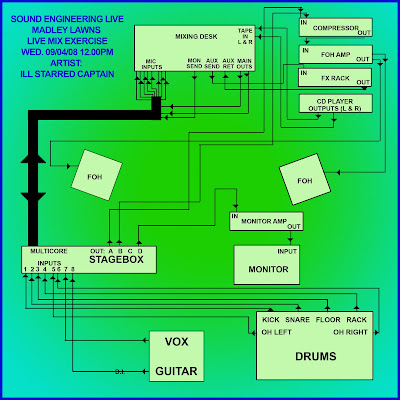
(This diagram represents a model of my ideal set-up for this gig):
As a live mixing exercise, the Madley Lawns gig of April 9 was an interesting starting point for the class. Outdoor live gigs that require sound reinforcement often have their own special set of problems, apart from the usual technical necessities of any live amplification situation.
It seemed that everyone in the group took on a number of roles that day, including setting-up, routing signals and mixing, and it was good to see them liaising confidently and politely with the band,
The featured artist on the day was two-piece Ill Starred Captain, whose line-up consisted of Scott on acoustic guitar and vocals and Jason on drums. From all accounts Ill Starred Captain are an experienced live and touring music duo and this was apparent in their organisation: they were quick to set up and had all the necessary equipment with them (including gaffer tape which none of us had thought to bring). Scott had his own DI box with him, which gave us a send directly from the guitar to the stage box without need for further miking. For his vocals, we used a Shure SM58 which ran into the stage box also.
Jason’s drums were mic’d as follows (he used only one rack tom):
KICK – SHURE BETA 52
SNARE – SHURE SM-57
RACK – SHURE SM-57
FLOOR – SHURE BETA 56
OVERHEAD LEFT – RODE NT-5
OVERHEAD RIGHT – RODE NT-5
All the microphone leads from this array fed directly into the stage box.
From the stage box, a bi-directional multicore took the microphone sends over the lawns to the mixing desk. From the mixing desk, Dave ran the main outs directly into the compressor and the compressor outputs in turn went back (via the multicore) to the stage box (A and B sends). The A and B sends were then routed from the stage box to the FOH amp, the outputs of which were fed into the FOH speakers.
A monitor send was taken from the desk via the multicore (D send) back to the stage box and thence to the monitor amp (which was up on the stage). The output of the monitor amp was then fed into the monitor speaker which was positioned between and facing the performers.
An auxiliary send was set up straight from the desk into the reverb unit, from which a return was sent back to the desk, enabling us to apply a little sweetening reverb to the vocals.
Finally, a CD player was plugged directly into the mixing desk (via aux returns as there was no "tape in") to provide music to start and end the set.
I thought the sound quality was good except that there were obvious issues with the overhead microphones picking up wind noise as it was a breezy day. We placed wind socks over the mics which helped but did not entirely eliminate the problem. Scott complained initially that he wasn’t getting much in the way of vocal foldback but this was quickly rectified by turning up the send from his vocal mic to the monitor bus. Also, when we recreated this set-up in the studio after the fact, the signal path was slightly different in that, instead of the compressor getting a signal straight from the desk before returning to the multicore, we set it up so that the signal went to the compressor from the desk outputs via the multicore. Dave said this was a better system anyway but I’m not sure why.
Given the size of the act and the space they were performing in, miking up the drums so comprehensively was possibly a redundancy but it was good in the context of the learning exercise.
All in all, a good day’s work – it was only a shame to see it cut short!
AUDIO STUDIES WEEK 8 PRO TOOLS CONTINUES
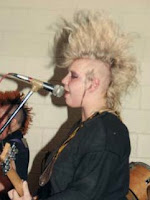
As we progress through the course, I find that we are now covering (some) things that I have discovered by accident, necessity and occasionally design by using PT in the studio. Region groups, mix and edit groups being most useful to me so far. Being an organisation- freak, I also found it useful to learn of all the “clean-up” functions available in the region pane. Anything that rationalises the files and streamlines the processor usage can only be a good thing. I’m not entirely sure that I comprehend the function of the playlists as opposed to just setting up more tracks, although Christian did explain the advantages of one technique over the other. It may become apparent when I start to use them. Sadly, I have nothing musical to upload as I’ve re-started my in-class exercise from scratch and my assessment piece not at all. All I can offer is this stupid photo of me circa 1990 which recently came into my possession, have a laugh oh, do.
SES WEEK 8 DRUM KIT MICING
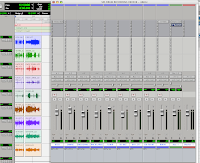
I booked 2 hours last Friday morning to mic up and record a drum kit in keeping with last week’s SES. Four of us had made arrangements to meet in the studio to do this, two of whom are drummers. In the event no-one showed up except me and Sam (I am naming no names, here). Our time was not wasted; I discovered that it is virtually impossible to set up a recording session for drums when you have to press record in the studio, run into the recording space and play something, run back to the studio and listen to it, adjust the levels, run back to the recording space and adjust the mics, run back to the studio and press record again…. you get the picture. At this point Sam showed up, bless ‘im, and we managed to spend the last 20 minutes getting something down. Sam and I are not drummers (yet, anyway). This is the (pretty standard) array that we used – there was no time left to experiment:
KD – BETA 52a
RACKS – BETA 56 X 2
FLOOR – BETA 56
SNARE – BETA 57a
HI HAT – NT5
OH’S – NT-5 X 2
ROOM – U87.
Given that it was the same drum kit in the same position as when we did the exercise (this is where I like the kit best in that room anyway), the results were pretty much the same, too. Here are 2 versions:
Sam’s mix down
Dorothy's mix down
I think mine's a bit bass-heavy - something to do with the nice monitors in Studio 2 which let you get away with that sort of thing (until you come home and realise how ridiculous it sounds). I had issues with the floor tom ringing (I reckon it’s somewhere around 700-800 Hz) which I found a nuisance also with my tech rehearsal recording that I did last week.
THANKS TO SAM FOR THE FILES AND PIX!
MTF WEEK 8 CLASS PRESENTATIONS 2
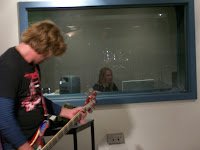
(This is Sam Glam on bass plus me pretending to be a sound engineer…)
This week we continued our investigation of engineers and producers through the researches of our class-mates. First up was Shane’s presentation on American musician and engineer, Patrick Carney. I’m a fan of the Black Keys and that new blues thing generally, so I enjoyed hearing about his very bohemian approach to recording music, “half parts cool shit and half parts broke ass shit”, was a good summary. Having allowed for the broke ass shit, the guy is obviously in possession of some fine skills as demonstrated by the incredibly gutsy sound of the Keys music. Interesting to note also, that he shares the opinion of Dave G with regard to there being a “right or wrong microphone” for any given recording job – the expensive mic isn’t always the right mic. Think I’ve got that down now. I thought Shane made a good job of it: he gave us a handout by way of support material and used music samples effectively to demonstrate his points. Well done, cobba! Next up was Kristie in the limelight who chose one Joe Barrassi, producer of Tool, the Melvins, Bad Religion, Anthrax and I’m sure many more. Kristie did a very thorough job of researching Joe’s background and recording techniques, something I missed in my presentation (my fault for choosing an obscure subject). I particularly liked the way that Kristie took a subjective stance in her presentation, ie: “I like this producer because…”. She’s the only one of us who has emphasised this point so far and it’s a good thing to do. Looking forward to next week’s exciting instalment.
Monday, May 5, 2008
CONCEPTS OF MUSIC WEEK 7 JND
A thoroughly enjoyable field trip once again as we journeyed this time into the locked-up and secret chamber that is Studio 4. This is obviously where they hide the good stuff; a treasure-trove of vintage analogue equipment which, sadly, students are verboten from using (for good and justifiable reasons, however). I can say that I was fortunate enough to use some of it once, long ago. We spent the lesson investigating the properties of sound in the context of “Just Noticeable Difference” (also called a “differerence limen”), where Stephen required us to listen to small variations in the frequencies of sine tones, both alternating and simultaneous. We decided that we could detect a variation of about 1/8th of a semitone, although I have read that experiments in 1950’s demonstrated it to be around 1/12th of a semitone. I presume this is entirely dependent on the subject – did we score badly, I wonder? It is easier to detect the variations when the tones are played simultaneously than when they are alternated, not least because of the beating that occurs. We also tried to detect certain frequencies at the bottom and top of the range of human perception. I was pleased to note that my hearing is almost as good as the rest of youse class youngsters (which was borne out by a hearing test I had done last Monday) – yay!
Sunday, May 4, 2008
AUDIO STUDIES WEEK 7 MORE PRO TOOLS
I’m becoming somewhat more comfortable with the Pro Tools environment and about time, too. What we are currently doing with Pro Tools in Audio Studies is somewhat different to how we use Pro Tools in Sound Engineering Studio but the information is obviously transferable from one subject to the other and I’m finding my SES sessions are proceeding more efficiently now, largely as a result of what I’ve picked up in Audio Studies. I still can’t seem to get any of the class workshops finished on time and, had I realised that the drum sequence that we started in week 4 or whatever was going to form the basis of our in-class project, I would have taken more pains over it because I think it sounds like crap, sadly. However, and on a happier note, I’ve chosen my topic for the major assessment and am looking forward to starting on that (assuming it meets with approval) as soon as possible. I’m also enjoying using the PT effects now that I know how they work and am looking forward to getting stuck into automation soon. I had a go at applying some volume automation to a guide vocal track that I recorded last weekend to see if it was salvageable, and the result looked like a roller coaster and sounded like some mad bugger had applied a hilariously unsubtle LFO to the amplitude which, in retrospect, is probably exactly what actually occurred. HAR!
SES WEEK 7 RECORDING VOCALS
Here are my vocal samples - better late than never, I spose:
SPOKEN WORD (ME + U87, DEAD ROOM)
SINGING (NATHAN + U87, DEAD ROOM, VOCAL OVERDUB FOR GLAMVILLE DEMO). ONCE AGAIN, I RAN OUT OF TIME BEFORE I COULD FIND THE RIGHT MIC FOR THIS VOICE. THIS ONE IS CLEARLY NOT IT!
Firstly, thanks to Bronwyn for coming in and being “guinea pig” for this week’s session. She said that she hadn’t had much experience or training in microphone technique and I thought she did very well and has a lovely voice besides. The emphasis during the lesson was twofold: firstly, determining the best microphone for your source, which exercise we have so far done for acoustic and electric guitars both, and obtaining the best performance that your subject is capable of on the day. Obviously, some days will be better than others for performers and Dave related to us the example of a drummer he was recording once who had to be sent away because his bad temper at the time was not only affecting his own performance but that of everyone else involved. There are other factors to consider in the case of singers particularly such as illness, comfort (if they’re feeling embarrassed or aren’t used to recording) and warming up (important for all musicians). Coaxing your singer into their best should be an exercise in tact also – you really don’t want to be telling someone that the singing they just did and were so proud of was crap and could they do it better this time, please? I have done my spoken word recording and will upload the mixdown here as soon as I can – am still working on finding a singer, however.
SPOKEN WORD (ME + U87, DEAD ROOM)
SINGING (NATHAN + U87, DEAD ROOM, VOCAL OVERDUB FOR GLAMVILLE DEMO). ONCE AGAIN, I RAN OUT OF TIME BEFORE I COULD FIND THE RIGHT MIC FOR THIS VOICE. THIS ONE IS CLEARLY NOT IT!
Firstly, thanks to Bronwyn for coming in and being “guinea pig” for this week’s session. She said that she hadn’t had much experience or training in microphone technique and I thought she did very well and has a lovely voice besides. The emphasis during the lesson was twofold: firstly, determining the best microphone for your source, which exercise we have so far done for acoustic and electric guitars both, and obtaining the best performance that your subject is capable of on the day. Obviously, some days will be better than others for performers and Dave related to us the example of a drummer he was recording once who had to be sent away because his bad temper at the time was not only affecting his own performance but that of everyone else involved. There are other factors to consider in the case of singers particularly such as illness, comfort (if they’re feeling embarrassed or aren’t used to recording) and warming up (important for all musicians). Coaxing your singer into their best should be an exercise in tact also – you really don’t want to be telling someone that the singing they just did and were so proud of was crap and could they do it better this time, please? I have done my spoken word recording and will upload the mixdown here as soon as I can – am still working on finding a singer, however.
Saturday, May 3, 2008
MTF WEEK 7 PRESENTATIONS AND MASH-UPS
This week we began the assessment presentations on Music Technology professionals. Sam chose to research one Mick Launay, and gave a good overall view of his work in the context of his background and history (growing up in Spain with hippy parents etc). It was an interesting co-incidence that he played an excerpt from a Mick Launay production of a Nick Cave song, given my choice of Tony Cohen as my presentation subject and Tony’s long association with Nick Cave and all his bands. I enjoyed listening to the difference in production style between the 2 engineers recording the same subject. Then there was me… what can I say? On to Seb who chose Dave Bottrill and gave a good account of his work and influences. Seb was stuck without visual material because of a lack of the right connection but he made a good job of it regardless. The second part of our session was spent with Dave L discussing remixes, mash-ups and the like, and what we thought of them. I got the impression that Dave was suggesting that, with the advent of specialist software today, this process has become little more than an academic or technical exercise rather than an artistic endeavour. I don’t think I agree as a whole but I there are definitely some people who take a VASTLY more creative approach to this type of work than others. One reference I’d like to make is to the Fear Factory album, “Fear is the Mindkiller” – I enjoyed these remixes for years until I heard the original (un-remixed) album and realised how dull it was. I’ll try to bring something along next week that demonstrates my point.
Sunday, April 20, 2008
SES WEEK 7 MUSIC UPLOAD
This is what I've been doing in Studio 2 over the last couple of weeks. I journeyed into the EMU with some helpers armed with an array of toy instruments and a 3/4 size 'cello (courtesy of Vlad) and we laid down a barrage of dodgy tracks, all in the name of familiarising myself with ProTools. I think we ended up with 12 tracks in all, which I've "top and tailed", stuck some effects on and bounced down - here's the result. What I couldn't figure out was applying fades and volume automation to some of the tracks. Also, I'd like to know how to apply effect to sections of tracks - looking forward to finding these answers and more in next week's exciting instalments of.... Uni. PS: I can't upload an MP3 because I have no software at home at the moment for various reasons and it seems that Studio 2 Pro-Tools will not allow you to bounce down as an MP3 directly - here 'tis: http://www.megaupload.com/?d=YPOTA291
Monday, April 14, 2008
AURAL STUDIES WEEK 6 THE EAR AND THE BRAIN
Once again, I feel like I have been through a wringer at the end of this session. I find the absence of Power Point in this classroom quite pleasurable and get the distinct feeling that I have learnt a lot more as a result. This week’s offering was a fascinating continuation of our journey into the ear and beyond, into the brain. The way that the brain processes intervals and changes in timbre and amplitude is definitely interesting and whilst looking up Place Theory on the web, I came across a related subject which was also of interest, namely: how our brain determines different vowel sounds as being the same when pronounced at different pitches. If you’re interested, I recommend you have a decko at this site, HyperPhysics, which has a really good section on the physics of sound and hearing, simply presented (upper high school level) – here’s the URL: http://hyperphysics.phy-astr.gsu.edu/hbase/hph.html#hph As for the in-depth examination of the organ of Corti, I now have this unshakeable idea that there are rapid firing pop-ups (like toast) occurring in my ears every time I hear anything. This disturbs me and I shall probably go mad and have to be counselled Dr Sachs. Perhaps his next book could be about me, “The Woman Who Mistook Her Ears For A Toast Rack”.
AUDIO STUDIES WEEK 6 PRO-TOOLS SEQUENCING
More Pro-tools theory and practical this week which is OK because I enjoy it even though I feel I’m slow at picking it up. Hopefully, I can get into the audio lab during the break and get up to speed. Like I said before, the theory side doesn’t faze me as much as the practical in this subject which is strange because usually it’s the other way around for me. Anyway, I’ve managed to get several sequences going, but I tend to spend a lot of time working on making them “musical” which perhaps is redundant in terms of getting the exercise done on time? I dunno. I find that working in grid mode seems to be the way to go, at least for these sequencing exercises although I assume that the slip or shuffle modes might be more appropriate when using Pro-tools for live recording. In general, I find the Pro-tools layout sensible, user-friendly and seemingly easy to customise, which is good for people like me who prefer to arrange their working environment in a highly personalised way. Also, the configuration of the time signatures and tempos seems straightforward enough and I’ll be looking forward to playing about with them in due course…
SES WEEK 6 GUEST GUITARIST
Many thanks to our special guest, kick-arse guitarist who came along this week and allowed us to perform EXPERIMENTS on him (hee hee, demonic laughter). These experiments were similar to those we carried out with vocals to listen to the variations possible with one voice and many mics, but this week’s session also gave us more of an insight into mic positioning variations. I found it useful to note that positioning the mic across the speaker at an angle rather than directly into the speaker gave a better result. I suppose that this is also the reason that you don’t stick kick drum mics directly into the drum facing the hammer. Speaking of hammers, Dave keeps hammering home that whatever works best, works best and stuff the rules (as long as you don’t actually blow anything up, I guess). Sound advice (get it, get it?). Of huge relief to me personally was the information that I am not in fact insane and that the recording-space-to-studio-2 patch had been repatched. I could have cried with frustration the week previously when I could get no signal from one to the other and no headphone mix (I suppose I should have tried ALL of the headphone outs in the recording space but who would have guessed that only 3 and 4 work? What do I do when I have more than 2 artists in there wanting headphone mixes?). See you after the “break”.
MTF WEEK 6 MORE THOUGHTS ON LISTENING
It’s getting a bit difficult to know what to blog on about with regard to MTF – we spend every week listening to CD’s. Now don’t get me wrong, I understand the whys and wherefores and how’d you do’s of this process but it’s hard to put into words the evolution that I am convinced is taking place within my sense of music perception. My notes for this week read, “Production techniques – used to bugger-up other people’s music”. Um, I can only assume the reasoning behind this somewhat bitter sentiment is the example that Dave played us first of the 13 year old girl and her sweet (and yes, somewhat sickly but she WAS 13) song played atrociously on acoustic guitar but attention-grabbing nevertheless. At least, I listened to it all the way through. Then the “produced” version, which lost my attention within 10 seconds – not only had the producer managed to “bugger-up” the innocent charm of the original but he/she had messed with the actual melody which didn’t need no messing. I am sure there is probably a way of retaining the naiveté of the original whilst making it more palatable for less masochistic palates than mine, so I can only assume that the producer in question was not up to the job. Leave well enough alone. OK, on to my choice of assessment producer – I decided to choose a LADY producer…. Oh, dear, there aren’t any. Bugger again.
Tuesday, April 8, 2008
SEL WEEK 6 EXERCISE MADLEY LAWNS GIG
MADLEY LAWNS LIVE SET-UP & MIX
WEDNESDAY APRIL 9, 12.00PM
ARTIST: ILL-STARRED CAPTAIN
LINE-UP: SCOTT – ACOUSTIC GUITAR (LIVE MIC)
VOCAL
JUSTIN - DRUMS
VOCAL
SET-UP NOTES
GUITAR: 2 X SHURE SM-57 MICS ON GUITAR DIRECTLY INTO DESK
GUITAR VOX: 1 X SHURE SM-58
DRUMS: KD: SHURE BETA 52
SD: SHURE SM-57
FURTHER MICING ON DRUMS PROBABLY REDUNDANT GIVEN SIZE AND NATURE OF VENUE
DRUM VOX: 1 X SHURE SM-58
MONITOR: (SAME SEND TO BOTH GUITAR AND DRUMS), VOX, GUITAR (KICK AND SNARE PROBABLY NOT NECESSARY THROUGH MONITOR BUT CAN BE SUPPLIED IF REQUIRED BY ARTISTS)
WEDNESDAY APRIL 9, 12.00PM
ARTIST: ILL-STARRED CAPTAIN
LINE-UP: SCOTT – ACOUSTIC GUITAR (LIVE MIC)
VOCAL
JUSTIN - DRUMS
VOCAL
SET-UP NOTES
GUITAR: 2 X SHURE SM-57 MICS ON GUITAR DIRECTLY INTO DESK
GUITAR VOX: 1 X SHURE SM-58
DRUMS: KD: SHURE BETA 52
SD: SHURE SM-57
FURTHER MICING ON DRUMS PROBABLY REDUNDANT GIVEN SIZE AND NATURE OF VENUE
DRUM VOX: 1 X SHURE SM-58
MONITOR: (SAME SEND TO BOTH GUITAR AND DRUMS), VOX, GUITAR (KICK AND SNARE PROBABLY NOT NECESSARY THROUGH MONITOR BUT CAN BE SUPPLIED IF REQUIRED BY ARTISTS)
Sunday, April 6, 2008
SES WEEK 5 RECORDING I SPOSE
Help! I took no notes this week, what on earth did we do? I think we got grouped- up and recorded a few radio tracks on pro-tools and miced up and recorded the long-sufferering Dave M, who should be knighted for his services to sound engineering students. It's all beginning to blur in my mind, however, I did manage to get into the studio on Thursday with my "artiste" and we laid down 3 hilarious tracks of "acoustic guitar": acoustic guitar being what Dave G asked for but I chose to bring two examples of this instrument from my home, one of which belongs to my 5 y.o. daughter and although it features tuning pegs, one can only assume that their function is ornamental as it is apparently untunable to any earthly configuration. My other domestic acoustic (nice ring, that phrase) bears what can only be described as a motley crue of strings and is likewise dubious in the realm of tuning. I like music this way. Getting tracks down was no problem but I had issues sorting out a headphone mix for my guinea pig - he alternately had no talkback (which was OK because he could read my lips through the glass anyway, ie: CAN YOU HEAR THIS, FOR CHRIST'S SAKE?!?), and then no mix of his previous tracks and then no mix of the current "live" track... comic antics but I got it sorted in the end by diligent application of my brain in the patchbay area. I have no mix-in-progress to play you as we ran out of time but I'll try to get something uploaded next week (after we lay down the vocal ululations and toy percussion tracks on Monday).
MTF WEEK 5 MASTERING
Another one of those "wow" factor sessions as we compared the before and after effects of mastering, the difference between which is dramatic to say the least. It was interesting for me to discover that top quality mastering is done on analogue equipment and reminded me of something we discussed earlier in the year in Audio Studies with Christian when we were comparing the characterisitcs of analogue and digital audio, namely that analogue audio devices at the extreme top end of the scale still sound better than their digital counterparts. I guess this is why this final stage of the production process is carried out in this way. I looked at a few audio mastering equipment suppliers and studios on the web and found that the most commonly used gear seems to be multi-band compressors and EQ's. The critical listening part of our sessions is beginning to take effect and I find myself hearing music in a different way: fortunately, this has not lessened my enjoyment of the music as I had feared it might but it hasn't increased it either... I was watching The Blues Brothers with the children last night and there's a scene with John Lee Hooker doing a killer blues song (what else) and it struck me how beautiful the production was: the style of the music was very loose and the individual instruments were all clear, warm and rich. The scene was outdoors but the song had obviously been recorded in a studio. I looked at the DVD cover but could find no indication as to whether the sound has been re-mastered for this edition - do they re-master the audio on old films when they're released as DVD's as a matter of course? This week's quiz question....
AUDIO STUDIES WEEK 5 SEQUENCING
This week's fun and games centred around sequencing in Pro-tools which, OK, I find bizarre. Mainly because I had only really thought of Pro-tools as a real-time recorder and I suppose that when you are working with samples and grid modes, yes of course there you have a sequencer but all of my sequencing in the past has been done in environments such as Fruity Loops within the framework of a nice simple graphic representation and which to me has been a natural progression of the analogue step sequencers of my mis-spent youth (sigh), ie: piss-easy. Having said that, we all know that Pro-tools is an immensely powerful program and, as I've said previously, the only way to come to grips with these is to spend a lot of time using them. So far I am having trouble with this - I can't find the extra time to get into the audio lab and may have to consider a visit or two in the dead of night to catch up, like some kind of Phantom of the 4th floor. I enjoy the theory side of audio studies and getting down and dirty with the anatomy of a sound file is interesting, as is the analysis of digital audio that we have been force-fed over the past few weeks. I feel like a goose, a goose with fois-gras destiny - whatever will become of my audiological liver (yes, it's past my bedtime, sorry)....
CONCEPTS OF MUSIC WEEK 5 THE EAR
Ear ear, what's all this then? Shades of Spike Milligan with a copper's tit on his head bending at the knees... Wonderful journey into the ear this week with many interesting discoveries along the way. I find the mechanism of the acoustic reflex fascinating and something of a relief to know that it exists but probably not much use in my chosen sub-profession as a rock planet (like a rock star but MUCH less impressive). I have broken the so far unblemished habit of a lifetime and consulted Wiki on this and found out the acoustic reflex is also activated when one speaks, ie: your own timpanic membrane (ear drum for you plebs) slackens off before you vocalise. You can use this to consciously limit the effect of expected loud sounds (by up to 20dB apparently). So if you're watching a military display and they're about to let off the cannon for example, you could cough and possibly limit potential damage to your hearing. Or you could put your hands over your ears. I suppose. I found of great interest also the precedence effect, about which there has seemingly been an awful lot of study done, but the overall impression I get is that the brain is really bloody talented at sorting stuff out and we should all just let it get on with the job. Second to last in this blog, I must explain that I have no proper word processor at the moment and consequently no word count facility, so I apologise for being either too long or too short in my reflections. And lastly, I must further apologise for the observation that in the human ear the conch is also known as the external auditory meatus and hence the expression, "prick up your ears".
Sunday, March 30, 2008
CONCEPTS OF MUSIC WEEK 4 GOOD VIBRATIONS
Good vibrations indeed! A meaty lecture to be sure and a thoroughly enjoyable excursion into the workings of sound. What is more confusing for yours truly was the analysis of well... the analysis of sound. I spent some time this afternoon looking at Fourier Transformations in the broadest possible sense. There’s a lot of chunky maths there that I simply didn’t bother with but I noticed in my internet meanderings that the applications of Fourier analysis seem vast, from engineering to digital multimedia. I think the theorem provides a method by which complex wave forms (or functions) can be represented as sine waves of different frequencies which sum the original wave form. This probably answers the question I asked in my Audio Studies blog this week about how complex waveforms are acoustically represented by audio equipment... or does it? How deep my understanding of this concept needs to be is something I’m not certain of at this point in my aural studies life, but I hope to find out. The beautiful harmonic series was explained; this concept I dealt with more easily as I remember it somewhat from high school music and physics both (I should probably remember the Fourier Transforms as well but...) and I enjoyed immensely Stephens manic pipe-twirling demonstration of same. Whatever shenanigans will he entertain us with next week? Great fun.
AUDIO STUDIES WEEK 4 SAMPLING THEOREM
Ah, at last I get my head wrapped firmly around the idea of sampling rate and bit depth, I hope. The concept of bit depth determining the amplitude resolution now makes sense as the amplitude over time determines the wave shape. I presume that the high rate of sampling coupled with the large number amplitude increments possible even at 16BD and 44.1kHz SR, is what allows accurate representation of the very complex sounds (wave shapes) that comprise music, although the graphic portrayals we have been looking at give the impression that everything comes out sounding like a sine wave, ha ha. This is another difficult concept to get used to: how do ears, speakers, microphones and digital representations reproduce complex sound structures? In the analogue realm, surely all things do is vibrate, in the digital they’re just on or off; how then do we hear a full orchestra and its individual components? I think someone brought this up in Concepts of Music this week also and although Stephen explained it to some extent, it’s a difficult thing to visualise (and some of us need to visualise to understand). I confess to having had some difficulty in completing the practical exercise on time this week. I’m unfashionably unfamiliar with the Mac environment and this is slowing me down – the actual software presents no problem for me, just finding documents. Silly, I know. I’ll get used to it in time.
SES WEEK 4 MICROPHONES

An exhausting (but not exhaustive by any means) survey of the microphone collection offered by the EMU. Of particular interest to me was the experiment whereby we set up 3 different microphones for the same source and listened to each independently. The lesson in this experiment was clear: there is no given “best microphone” for any application and different microphones will give better (or worse) results for different sources in different locations and who knows, maybe even different atmospheric conditions! The differences in the microphones’ warmth and colour were far more obvious when applied to a female (higher frequency) voice as supplied by Kristie than they were when we listened to the manly tones of Sam and Joe. I found that interesting to note also. I’ve done some research and found that the cardioid polar pattern is constructed by a sort of “combination” of the techniques used in omni and figure 8 polar patterns, where the shape of the cardioid is determined by the amount of either polar pattern engineered into the microphone. The question of how this is achieved arose during the lecture and it was suggested that this was done electronically within the mic but I get the impression that there is also an acoustic labyrinth behind the diaphragm which determines the final spatial sensitivity. Here’s a couple of links which provide really good microphone theory overviews: http://www.soundonsound.com/sos/mar07/articles/micpatterns.htm
http://ccrma.stanford.edu/courses/192a/SSR/Microphones.pdf. (THIS IS A PDF, AS IT SAYS)
http://ccrma.stanford.edu/courses/192a/SSR/Microphones.pdf. (THIS IS A PDF, AS IT SAYS)
MTF WEEK 4 CRITICAL LISTENING
This week’s session was almost entirely focussed on critically listening to “pop”* recordings and discussing the production attributes of them. Both Daves seem keen for us to understand that there is no “right way” or “wrong way” to produce, in the final analysis the recording either sounds good or it doesn’t, irrespective of the production techniques employed. I should qualfy the phrase “sounds good” in this context, as there are certainly different levels of listening. One wouldn’t necessarily expect the same level of critical listening from the average pop music CD purchaser as one would from a professional sound engineer. So why are we striving for maximum quality in every project when the final market might be say, AM radio? I think it’s because no matter what market you are producing your recording for, you never really know what system the music is going to be played on. So the Kylie recording which sounds OK on your crappy home hi-fi may not so sound so good on your extremely expensive professional sound system. Also, if someone is paying you top dollar to produce their music, then surely you owe them the best that you are capable of. The other lesson I learnt this week is that going to a reputable studio is no guarantee of top quality production, there must be more to the process than simply spending money and this is probably where the producer, and specifically the producer in partnership with the engineer, comes into play. If the band in question has no producer and has a vague idea of their own role as self-producers, then the end result might not be all that they are hoping for.
*I use the word “pop” here in the broad sense of “popular” music of all genres.
*I use the word “pop” here in the broad sense of “popular” music of all genres.
Tuesday, March 25, 2008
CONCEPTS OF MUSIC WEEK 3
As I sit here blogging away (oh, what a revolting concept), I am conscious of the fact that I didn’t wear my ear plugs at band practice last night and my ears are ringing merrily away – shades of Quasimodo… “the bells, the bells!”. I now have transient-tinnitus phobia and will never so much as set foot outside of an anechoic chamber again without being equipped with industrial-strength hearing protection. On the subject of which (great segue, me), wasn’t last week’s field trip cool? What a wonderful experience! My only regret was not being able to hear my heart beat in the anechoic chamber from which I conclude either; that I am the walking dead or I was surrounded by giggling sound engineering students. Alright, I giggled too. Next the tremulous thrill of the lethally revolving reflector in the echoic chamber, so reminiscent of some James Bond slow-death scenario presided over by a cackling madman (who somehow doesn’t have time to hanG around and make sure JB actually dies). The study of sound as an abstract is becoming increasingly enjoyable to me, balanced as it is in this course by the study of audio in very physical detail. In closing, I mentioned to (visiting from interstate) Dad that I’d had an anechoic experience which launched him into reminiscences of his time at Bavarian Radio immediately post WWII. He recalled that not only did they have an anechoic chamber, they apparently had a “concrete room in the cellar with a giant steel plate”… this week’s quiz is: What was the room used for?
AUDIO STUDIES WEEK 3 EDITING
And so we get gritty with the nitty at last. I’m not sure I’ve quite got my head around the sampling rate and bit depth concepts. I’m happy with the verbal definitions but the visual presentation via the diagrams Christian furnished leaves me confused. Oh, and the idea that each sample/ snap shot is a representation of the sound’s amplitude at that time… surely there should also be some information as to the frequency and other characteristics or you would just end up with a digital representation of the amplitude envelope of the sound? As far as using the software goes (Bias Peak LE again), I have no issues with that. It seems like fairly straightforward editing analogous to video or even word processing when you get down to it. It’s funny how computers have enabled us to do pretty much the same things over a large range of applications, I suppose that’s the advantage of “non-linear” access but it still seems two dimensional in some ways. As to the pros and cons of analogue versus digital media, personally I had never given it much thought before. One just accepts the technology as it happens on the assumption that it must be an improvement on what was available before. Upon analysis, it seems that this assumption works in the field of audio and sound engineering, at least within the realms of technology which can be afforded by mere mortals such as myself.
Monday, March 24, 2008
MTF WEEK 3 THE BIG BAD RECORD INDUSTRY
More discussion about the respective roles about the music producer and the studio engineer and I must admit that, as an (alleged) artist, I find the idea of someone meddling in my musical affairs quite repellent, though perhaps I would feel differently if I was being paid in 6 figure amounts for my music. So, we understand that the producer has a great deal of creative control of the project content while the engineer is relegated to the task of making everything sound good, sometime hampered or assisted in this process by the producer once again. However, the jobs cross over to some extent and, in smaller recording projects particularly, it is not uncommon for the engineer to wear the hat of the producer and even the humble artist to assume some responsibility for the content of their own CD, wow. The subject of royalties is one of perpetual interest to me as I’m always trying to find ways of getting some. The trick in the music biz seems to be to write hit songs, and have some big name perform them (now that I know this, I expect to get rich as soon as I stop blogging and start writing songs again). The song writer gets the sales royalties, the performer gets performance royalties and there are mechanical royalties to be divvied up as well. Where the hell’s mine?
SES WEEK3 SIGNAL PATH AND GAIN STRUCTURE

OK yes, here am I still giggling about the concept of the wall bay as a “wallaby”, particularly given the context of the EMU studio. What led you astray, Liana? But I’m like that. So we discussed signal path – it’s the path the signal travels, apparently (I would never have guessed) but we kinda watched its progress through the wallaby and into the Studio 2 Pro-tools set up. This followed by an attempt to stimulate the studio monitors into action given that they had now been apparently permanently wired into the master output (which seems like the logical thing to me and I wonder why they weren’t before?). Also, the control room wallaby has apparently been repatched and relabelled, specifically to embarrass David while he is trying to maintain the flighty attention of Sound Engineering students. It was a good practical exercise in tracking down problems, though I still reckon that 6 people at a time in the control room is enough. I can’t see or hear what’s going on. We mic’d up the ever present crappy radio and obtained the desired effect at the end, while I gained some useful insights into other people’s musical tastes, ahem. Gain structure, well... the cut or boost applied to the signal as it jaunts along its path. Both of this week's concepts are crucial to successful audio production, both live and in the studio, it seems to me.
Sunday, March 16, 2008
CONCEPTS OF MUSIC - WEEK 2
More definitions! I notice a relationship between concepts that we had discussed in Audio Studies to those discussed in the Aural component of this week’s Concepts of Music lecture, namely: sound as a physical event and sound as a subjective experience (psychophysical). It’s becoming clear to me that sound engineering involves finding a working balance between those definitions of sound within one’s professional life and that good sound engineers are possessed of both a useful pair of ears, as well as a fine sense of auditory discrimination and the ability to truly hear and analyse perceived sound. I found it interesting to examine the supposition that the relationship between quantifiable and qualifiable sound is a non-linear one: this makes sense and is one of those things that one probably knows at some instinctive level but has no reason to expound upon (until one embarks on a potential career as a sound engineer anyway). As Stephen said, the ear is the final judge but the tools in the studio environment can make the engineer aware of changes in sound that he or she cannot otherwise detect. I wonder how useful this is? If the engineer, with their supposedly refined hearing skills, cannot detect these sonic variations, are they of any importance, given the supposition that most of the sound being produced in the world is designed for human beings to listen to? Nathan (reading over my shoulder) suggests that minor, undetectable variations in the components of the mix may have a cumulative effect, which when compounded become noticeable. Leave it with you....
AUDIO STUDIES WEEK 2 WHAT IS AUDIO?

In these first 2 weeks the focus is around getting definitions and differences sorted out: physical vs. psychophysical sound, listening vs. hearing, analogue vs. digital etc. This week’s audio studies class delved into almost Einsteinian regions of wave vs. particle natures, where the analogue audio signal is represented as a continuous stream of audio information while the digital signal manifests itself as a series of discrete, numerically represented “bits” of data, replayed at such speed that the ear cannot detect the individual sounds. It’s interesting that the ear is more discerning in determining individual events than the eye, as per the example Christian gave of video/ film. I believe the frame rate of film is something like 24 frames per second and I wonder what music would sound like if we captured the sound at a rate of 24 times per second and played it back. Is that how it works? Is that what the “bit rate” in Pro-tools refers to? If so, I think the rate was around 44.1 kHz, ie: 44,100 samples per second?
We also looked at hardware and software and mucked around with unpatched hardware in the lab. My philosophy on software is: just do it. Usually, once you get your hands on the mouse and are surrounded by a bunch of people with various degrees of experience in the application, things become clear fairly quickly. Today’s piccy is my audio studies doodle, I’ll try to include something more relevant next time.
We also looked at hardware and software and mucked around with unpatched hardware in the lab. My philosophy on software is: just do it. Usually, once you get your hands on the mouse and are surrounded by a bunch of people with various degrees of experience in the application, things become clear fairly quickly. Today’s piccy is my audio studies doodle, I’ll try to include something more relevant next time.
Saturday, March 15, 2008
SES WEEK 2, SEETING UP AND PRO-TOOLS
This week’s lecture emphasised the importance of planning a recording session in advance, down to the nitty gritty. I suppose it’s obvious in retrospect that to arm yourself with information regarding the number of pieces to be recorded, the instrumentation for each, the musicians names, the availability and type of equipment on hand at the studio and more, can only result in the recording proceeding smoothly and producing a better result... as a result. Some of the information David recommended gathering wouldn’t have occurred to me naturally, particularly: designing the track placement, room placement and recording schedule in advance, but I see the sense of it. I also think that, as an engineer, one would need to adjust one’s research to the scale of the proposed project, ie: there’s not a lot of point in spending hours following a band around at rehearsals and gigs, and pumping them about their favourite beer etc if this same band is planning on spending around $500 to thrash out a 3 song demo in your studio over the course of the day (including overdubs and mix-down!). Common sense prevails (probably). The next part of our workshop involved designing a (band) recording session and setting-up the project in Pro-tools. I’d be happier if there was a projector or something feeding off the Pro-tools monitor as I couldn’t see a damn thing David was doing, however, the software seems (fortunately) fairly straightforward and I’m anticipating having a bash at it.
MTF WEEK 2
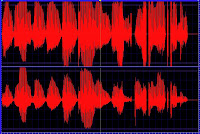
The main areas covered in this week’s forum embraced 2 aspects of the pop music recording process: what makes a pop song and what constitutes a good recording? I have (co-) written over 100 songs and hope that no-one EVER refers to them as pop music, however, I recognise that there is a formula, with variations, inherent in popular music and present in my own work. Philosophically, I wonder if a pop song HAS to be structured this way to be “popular”. Is it necessary to assume a “lowest common denominator” in our target audience, ie: are the punters really so stupid they can’t deal with any other musical format? Leave it with you. (NB: I remember lessons on music structure when I was in high school and I THINK the technical term for a song made up of verses and choruses is “strophic”.) Regarding recording process, we mused at length about compressors which equipment I have heard of but never really understood the function of before. Great! The underlying premise of quality recording seems to be one of extreme common sense: to ensure high quality recording, you must use high quality instruments, mics, signal processors and recording devices and position your sources with care and thought. Actually, that’s probably a bit simplistic and I’m sure isn’t always the case! The above is a screen shot from Cool Edit of a wave on which I whacked some compression willy-nilly (left channel only) for comparison).
Tuesday, March 4, 2008
SES WEEK 1 MIC LEADS AND STANDS

Today's lecture was good news. I suppose it put the whole Diploma in context for some of us who are perhaps feeling a little bemused by the Uni environment, which can leave one overwhelmed with procedure. However, we broached the confines of the studio and lo, we now have a justification for that which has come before and a sense of anticipation for that which is to follow (I'm being subjective and reflective, not to mention silly, here).
On a practical note, what can compare with the satisfaction of watching a smoothly uncoiling microphone lead trail obediently behind one across the floor, knowing all the while that one has caused this poetry-in-motion to be? To experience at first hand the workings and mechanical ingenuity of a precisely engineered microphone stand - so distant a cry from the, dare I say it, crap that one is so used to employing in the course of one's employment as the lowest quality of live musician. Finally, the tremulous thrill of clutching $6000 worth of Neumann microphone (spelling uncertain) is a highlight I shall certainly be sharing with my nearest and dearest.
It's a shame that such a long school day precedes the studio session - I for one would love to approach the studio with a fresh brain (my own), but c'est la vie and whoopee, "we gonna have some fun tonight". (That was my first, last and only un-serious post, promise)
MTF WEEK 1 INTRODUCTION

Hi everyone - this is just me checking out this blog biz which is probably totally old-hat to everyone else but fun for me - yay!
Here's an amusing pic one of my children snapped of me at a "spooky" birthday party (I'm just checking out this embed piccy stuff, OK?): note the scotch n dry in left hand....
Subscribe to:
Posts (Atom)
